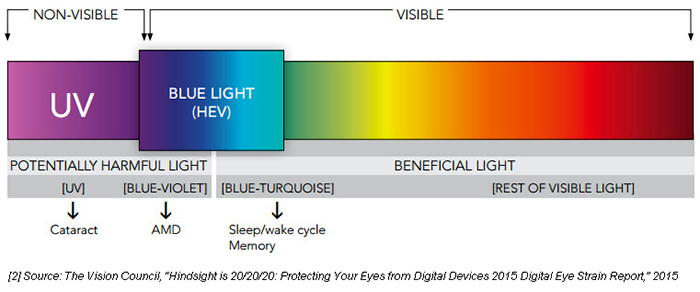WHAT IS BLUE LIGHT?
Blue light's wavelengths fall between 380nm to 500nm, which is therefore considered High-Energy Visible (HEV) light for this reason. Of particular interest, is the blue-violet band between 415nm and 455nm, which researchers [1] consider to be the most harmful to the health of our retinal cells.

Blue light can actually be found in light that appears white, such as sunlight as well as LED lighting and light emitted from the many digital devices we can't live without today, such as smartphones (emit the most blue light), tablets, laptop/desktop computers, TVs etc. Coincidentially, many of these devices emit blue light that typically fall into the above mentioned, harmful range of blue-violet light.
WHO IS MOST AT RISK TO CUMULATIVE EXPOSURE TO BLUE LIGHT?
- 60% of adults spend more than 5 hours per day on digital devices
- 30% of adults spend more than 9 hours per day on digital devices
- Americans across all age groups check their smartphones 46 times a day (i.e. once every 31 min) [3]
- People aged between 18 and 24 check their smartphones an average of 74 times a day (i.e. once every 19 min) [3]
- People aged between 25 and 34 check their smartphones around 50 times a day (i.e. once every 28 min) [3]
- People aged beteen 35 and 44 check their smartphones on average 35 times a day (i.e. once every 41 min) [3]
- 1 in 4 kids in the US spend more than 3 hours per day being exposed to digital devices
EFFECTS OF CUMULATIVE EXPOSURE TO BLUE LIGHT
Emerging studies suggest frequent and cumulative exposure to blue light causes irreversible damage to the retinal cells in our eyes (retinal cells cannot regenerate) that could lead to health problems such as age-related macular degeneration (AMD) and cataracts further down the track.
Using blue-light emitting digitial devices just before bedtime could also affect the quality of your sleep, since blue light disrupts our normal circadian rhythms by suppressing the natural release of melatonin; a hormone released by our pineal gland, which prepares our bodies for sleep.

HOW TO MINIMIZE EXPOSURE TO BLUE LIGHT EMITTED FROM DIGITAL DEVICES?
Aside from minimizing the amount of time we spend using our smartphones and other devices, blue light control/blue light blocking glasses should be worn when using our digital gadgets.
The special patented lens technology incorporated into our blue light control lenses minimizes the transmission of HEV/blue light (thus minimizes damage to retinal cells) while optimizing color contrast (reduces eye-strain / improved comfort) with minimal distortion to color perception.
By filtering out harmful blue light that suppresses the release of melatonin, recent research suggests this results in improved sleep quality, which in turn is vital to our health and well-being in the long run [4].
[1] Arnault E, Barrau C, Nanteau C, Gondouin P, Bigot K, et al. (2013). Phototoxic Action Spectrum on a Retinal Pigment Epithelium Model of Age-Related Macular Degeneration Exposed to Sunlight Normalized Conditions. PLoS ONE 8(8): e71398. doi:10.1371/journal.pone.0071398 (August 23,2013).
[2] The Vision Council, Hindsight is 20/20/20: Protecting Your Eyes from Digital Devices 2015 Digital Eye Strain Report, 2015
[3] Lisa Eadicicco, Americans Check Their Phones 8 Billion Times a Day,Time, Dec. 15, 2015
[4] Ayaki M, Hattori A, Maruyama Y, Nakano M, Yoshimura M, Kitazawa M, Negishi K, Tsubota K. Protective effect of blue-light shield eyewear for adults against light pollution from self-luminous devices used at night. Chronobiol Intl. Published online on 5 January 2016. DOI: 10.3109/07420528.2015.1119158

 Canadian Dollar (CAD)
Canadian Dollar (CAD)
 Euro (EUR)
Euro (EUR)
 British Pound (GBP)
British Pound (GBP)
